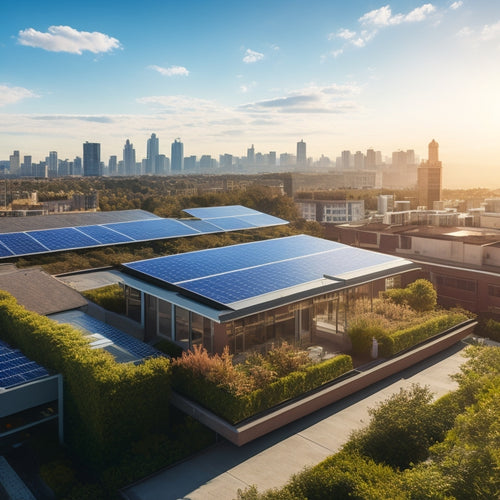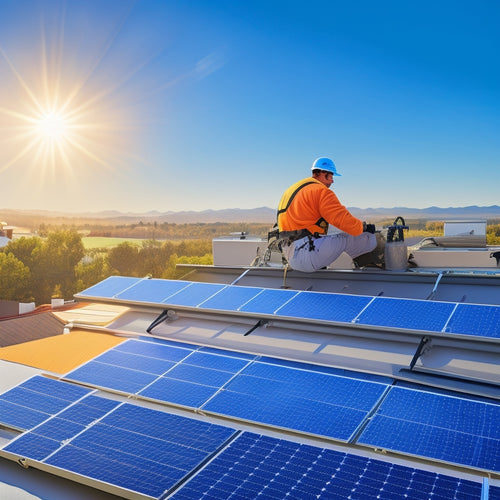
3 Essential Steps for Calculating Solar Power System Size
Share
To accurately calculate your solar power system size, you'll need to follow three essential steps. First, determine your daily energy requirements by calculating your energy consumption in watt-hours and identifying high-consumption devices. Next, assess your solar resource by evaluating the available solar radiation at your location, considering factors like shading and climate. Finally, size your system by selecting the right panel types, evaluating component efficiency, and ensuring the system capacity aligns with your calculated energy needs. By following these steps, you'll be well on your way to designing a solar power system that meets your unique energy demands - and there's more to investigate to optimize your system's performance.
Key Takeaways
- Determine daily energy consumption in watt-hours (Wh) by gathering past electricity bills and using energy monitoring devices for accuracy.
- Assess the solar resource available at the location, considering geographic influence, shading, and orientation of the installation site.
- Calculate the total daily energy consumption and evaluate the efficiency of solar panels, inverters, and components to select the right system size.
- Ensure the system capacity aligns with calculated energy needs, accounting for seasonal variations in energy usage patterns.
- Consider the location and orientation of the installation site to optimize energy production and select appropriate panel types.
Determine Your Energy Requirements
To determine your energy requirements, you need to calculate your daily energy consumption in watt-hours (Wh). This involves tracking your energy usage patterns to identify your peak usage periods and overall consumption.
Start by gathering your past electricity bills to get an idea of your average daily energy consumption. You can also use energy monitoring devices or smart meters to get more accurate readings.
Next, you need to identify the devices that consume the most energy in your home or business. This includes appliances, lighting, and HVAC systems. Calculate their individual energy consumption in Wh and add them up to get your total daily energy consumption.
Be sure to take into account seasonal variations in energy usage, as your peak usage may differ during summer or winter months.
Accurately calculating your energy requirements is essential in determining the size of your solar power system. A correctly sized system guarantees that you generate enough electricity to meet your energy needs, reducing your reliance on the grid and maximizing your savings.
Assess Your Solar Resource
With your energy requirements calculated, you're now ready to evaluate the solar resource available at your location. This step is essential in determining the size of your solar power system, as it directly affects the amount of electricity your system can generate. The amount of solar radiation your location receives is a key factor in determining your solar resource.
Solar radiation varies depending on your geographic location, with areas near the equator receiving more radiation than those closer to the poles. You can use online tools, such as the National Renewable Energy Laboratory's (NREL) PVWatts Calculator, to determine the average daily solar radiation your location receives. This value is typically expressed in kilowatt-hours per square meter per day (kWh/m²/day).
Additionally, you should consider the shading and orientation of your installation site, as these factors can also impact the amount of solar radiation your system receives.
Sizing Your Solar Power System
Now that you've assessed your solar resource, you're ready to determine the size of your solar power system. This involves calculating the required system capacity to meet your energy needs. To do this, you'll need to evaluate several factors, including your energy usage, system efficiency, and panel types.
When sizing your solar power system, keep the following in mind:
-
Energy usage: Calculate your total daily energy consumption in watt-hours (Wh). This will help you determine the required system capacity.
-
System efficiency: Evaluate the efficiency of your solar panels, inverters, and other system components to guarantee you're getting the most out of your system.
-
Panel types: Choose the right panel type for your system, evaluating factors like efficiency, durability, and cost.
- Location and orientation: Take into account the orientation and location of your solar panels to maximize energy production.
Frequently Asked Questions
Can I Install a Solar Power System Myself?
You can attempt a DIY installation, but be aware that it's essential to prioritize safety considerations, making certain you're well-versed in electrical and roofing aspects, as well as local building codes and permits, to avoid risks and guarantee a successful project.
How Long Does a Solar Power System Last?
You're probably wondering how long your solar power system will last - a typical solar lifespan spans 25-30 years, with performance degradation averaging 0.5-1% annually, ensuring you'll still generate significant power over time.
Are Solar Power Systems Resistant to Weather Damage?
You'll be relieved to know that solar power systems are designed with storm resilience in mind, featuring hail protection measures like tempered glass and anodized aluminum frames to guarantee your system withstands harsh weather conditions.
Can I Sell Excess Energy Back to the Grid?
You can sell excess energy back to the grid through net metering, which measures your system's production and consumption; you'll receive energy buyback rates for the surplus, offsetting your utility bills and maximizing your solar investment's financial benefits.
Are There Any Maintenance Requirements for Solar Panels?
Think solar panels are maintenance-free? Think again! You'll need to clean them regularly to guarantee maximum energy production, and don't forget to check your inverter's performance to prevent efficiency drops - your wallet (and the planet) will thank you.
Conclusion
You've reached the final milestone in calculating your solar power system size. Now, imagine your solar panels as a perfectly aligned orchestra, harmoniously working together to generate energy. Each component, like a skilled musician, plays its part to create a harmony of sustainability. With your energy requirements, solar resource, and system size in sync, you're ready to conduct your own clean energy concert, powering your home or business with precision and efficiency.
Related Posts
-

10 Essential Bike Lane Safety Features to Consider
You're designing a bike lane with safety in mind, and that's essential. The National Highway Traffic Safety Administr...
-

What Is the Cost to Put in Solar Panels
You're likely considering solar panels for your home, and the most significant factor in your decision is the upfront...
-

3 Essential Steps for Solar Electricity Installation
To guarantee a successful solar electricity installation, you'll need to follow three essential steps. First, assess ...


